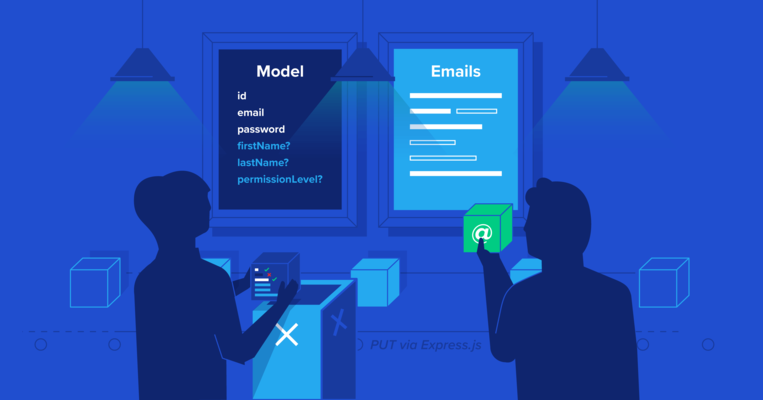
Hire Back-end Developers
Hire the Top 3% of Freelance Back-end Developers
Our back-end developers focus on building the engine that powers your applications. With expertise in server-side logic, database management, and API creation, they craft scalable systems to handle high traffic, complex workflows, and advanced functionalities with ease.
No-Risk Trial, Pay Only If Satisfied.
Hire Freelance Back-end Developers
Marcus Young
Marcus is a senior engineering leader with 15+ years of overall experience and 7+ years of experience leading back-end software development. As a staff software engineer in the fintech industry, he focused primarily on building cloud-native distributed systems and AI/ML pipelines to facilitate loan origination, payments, and fraud detection. Having recently worked on LLM-backed systems, he is looking forward to tackling the challenges associated with deploying and supporting LLMs in production.
Show MoreTudor Vlad
Tudor is a senior IT professional with over 15 years of experience, focused on creating meaningful impact via software. He is an Agile practitioner and a team player. He has architected, led, and/or co-managed the development of four SaaS products and one physical asset procuring and leasing service since 2015. As an architect and senior back-end engineer, Tudor works closely with clients across various industries, including finance, payments, fintech, insurtech, and eCommerce.
Show MoreAdam Bernot
Adam is a software engineer specializing in back-end development, with additional expertise in DevOps and front-end development. He loves working with Go, Kubernetes, and cloud-native applications. Adam has extensive experience in leadership, diverse issues, collaboration, and compassion. He believes it's the people who make the work fantastic.
Show MoreFrank Ji
Frank is a seasoned professional currently working as a software engineer at Amazon. He previously served as the VP of engineering at Penfield.AI, a Toronto AI startup pioneering in empowering human-machine intelligence in the cybersecurity space. Frank also worked as a senior engineer at Meta's enterprise trust organization, helping to build Facebook's privacy and compliance software infrastructures. He also worked on IBM WebSphere Java Runtime, which powered many Fortune 500 Java applications.
Show MoreDavid Grigorian
David is a seasoned full-stack software engineer specializing in back-end development. As the lead engineer, he's led the development of a truck and load scheduling platform now used by the largest US trucking company. As the back-end architect and co-founder of ParcelRobin, David has driven the startup to six-figure annual revenue with over a thousand loyal users. He delivers impactful solutions, leveraging his extensive experience to innovate and optimize software development processes.
Show MoreXiao Huang
Xiao is a software engineer with several years of professional experience in developing large-scale software primarily in automotive, including autonomous driving, navigation systems, etc. Xiao's primary language is C++, but he also has development experience in Python, MATLAB, and CUDA. Other than delivering products, Xiao has worked on build systems and continuous integration pipelines.
Show MoreMarco Martins Castanho
Marco is a software engineer with nine years of experience in IT, focusing on both back-end and front-end development. After graduating with an MSc in electrical engineering and computer science, he worked as an IT consultant in Lisbon, Portugal. He accepted the challenge of moving to France to gather experience working in international contexts. Since then, Marco has worked as a software engineer, technical lead, and scrum master on various projects.
Show MoreVlad Berindei
Vlad is a highly skilled software engineer with an extensive background in algorithms and computer science. He has 5+ years of experience working on back-end services and distributed systems at Google. Vlad is looking for new and challenging projects that would allow him to show his proficiency in C, C++, Python, SQL, and other languages.
Show MoreDavid Sumegi
Backed by several years of hands-on experience, David is a software developer who excels at building Java back-end services, relational databases, and software architecture. His solid testing background makes him the type of developer who prevents incidents early on via automated tests with 100% code coverage. David is also an enthusiast of SOLID principles, clean code, clean architecture, and design patterns.
Show MoreEmil Stoev
Emil is an engineering lead with over 20 years of experience in software development and team management. He has a proven track record in leading agile teams and optimizing processes. Emil has expertise in a wide range of technologies, including .NET, C#, C++, Python, Azure, and AWS.
Show MoreVadim Ovcearenco
Vadim is an accomplished senior software engineer with over 20 years of experience. Vadim has a solid technical background and extensive expertise in both front- and back-end web development, interactive web applications, and more, enabling him to deliver exceptional results across various projects.
Show MoreDiscover More Back-end Developers in the Toptal Network
Start HiringA Hiring Guide
Guide to Hiring a Great Back-end Developer
Back-end developers are essential to building the foundation of modern, high-performance applications. Their expertise in handling server-side logic, databases, and APIs makes them invaluable for creating robust and scalable cloud infrastructure, distributed systems, and high-traffic web services. This guide provides essential tips for hiring skilled systems developers, including drafting a job description that attracts top talent and examples of technical questions to help assess candidates' ability to develop and maintain efficient, secure, and scalable systems.
Read Hiring Guide... allows corporations to quickly assemble teams that have the right skills for specific projects.

Despite accelerating demand for coders, Toptal prides itself on almost Ivy League-level vetting.









How to Hire Back-end Engineers Through Toptal
Talk to One of Our Client Advisors
Work With Hand-selected Talent
The Right Fit, Guaranteed
EXCEPTIONAL TALENT
How We Source the Top 3% of Back-end Developers
Our name “Toptal” comes from Top Talent—meaning we constantly strive to find and work with the best from around the world. Our rigorous screening process identifies experts in their domains who have passion and drive.
Of the thousands of applications Toptal sees each month, typically fewer than 3% are accepted.
Capabilities of Back-end Developers
Unlock the power of custom back-end development. Our expert developers deliver scalable, secure, and high-performance server-side systems tailored to support your applications and business needs.
Custom Development
Database Design and Optimization
API Development and Integration
Authentication and Authorization
Cloud-based Solutions
Scalable Server Architecture Design
Performance Tuning and Optimization
Microservices Architecture Expertise
DevOps and Continuous Integration/Continuous Deployment (CI/CD)
Security-first Development
Find the Right Talent for Every Project
Senior Back-end Developers
Dedicated Back-end Developers
Offshore Back-end Developers
Remote Back-end Developers
FAQs
How much does it cost to hire a back-end developer?
The cost associated with hiring a back-end developer depends on various factors, including preferred talent location, complexity and size of the project you’re hiring for, seniority, engagement commitment (hourly, part-time, or full-time), and more. In the US, for example, Glassdoor’s reported average total annual pay for back-end developers is $110,000 as of October 2024. With Toptal, you can speak with an expert talent matcher who will help you understand the cost of talent with the right skills and seniority level for your needs. To get started, schedule a call with us — it’s free, and there’s no obligation to hire with Toptal.
How quickly can you hire with Toptal?
Typically, you can hire back-end developers with Toptal in about 48 hours. For larger teams of talent or Managed Delivery, timelines may vary. Our talent matchers are highly skilled in the same fields they’re matching in—they’re not recruiters or HR reps. They’ll work with you to understand your goals, technical needs, and team dynamics, and match you with ideal candidates from our vetted global talent network.
Once you select your back-end programmer, you’ll have a no-risk trial period to ensure they’re the perfect fit. Our matching process has a 98% trial-to-hire rate, so you can rest assured that you’re getting the best fit every time.
How do I hire back-end developers?
To hire the right back-end specialist, it’s important to evaluate a candidate’s experience, technical skills, and communication skills. You’ll also want to consider the fit with your particular industry, company, and project. Toptal’s rigorous screening process ensures that every member of our network has excellent experience and skills, and our team will match you with the perfect back-end developers for your project.
How are Toptal back-end engineers different?
At Toptal, we thoroughly screen our back-end experts to ensure we only match you with the highest caliber of talent. Of the more than 200,000 people who apply to join the Toptal network each year, fewer than 3% make the cut.
In addition to screening for industry-leading expertise, we also assess candidates’ language and interpersonal skills to ensure that you have a smooth working relationship.
When you hire back-end architects with Toptal, you’ll always work with world-class, custom-matched back-end developers ready to help you achieve your goals.
Can you hire back-end architects on an hourly basis or for project-based tasks?
You can hire back-end programmers on an hourly, part-time, or full-time basis. Toptal can also manage the entire project from end-to-end with our Managed Delivery offering. Whether you hire a back-end developer for a full- or part-time position, you’ll have the control and flexibility to scale your team up or down as your needs evolve. Our back-end developers can fully integrate into your existing team for a seamless working experience.
What is the no-risk trial period for Toptal back-end programmers?
We make sure that each engagement between you and your back-end developer begins with a trial period of up to two weeks. This means that you have time to confirm the engagement will be successful. If you’re completely satisfied with the results, we’ll bill you for the time and continue the engagement for as long as you’d like. If you’re not completely satisfied, you won’t be billed. From there, we can either part ways, or we can provide you with another back-end developer who may be a better fit and with whom we will begin a second, no-risk trial.

How to Hire Back-end Developers
Demand for Back-end Developers Continues to Expand
Cloud computing powers today’s tech landscape, and server-side engineering drives its core. As of October 2024, Indeed lists more than 4,000 job postings demanding back-end software developers—twice the 2,000 for front-end roles. Server-side work handles the heavy lifting: crafting scalable, rock-solid systems that power everything from streaming giants to fintech disruptors. Front-end polishes the surface; server-side anchors the foundation.
Hiring a systems engineer in this market can feel like a high-stakes treasure hunt. Tech titans like Netflix, LinkedIn, and Amazon, alongside agile innovators like Stripe, Uber, and Coinbase, compete fiercely for the same skilled candidates, shrinking the available talent pool for everyone else. Identifying someone who can architect and scale complex systems proves challenging. Selecting the best one demands razor-sharp discernment.
This guide cuts through the complexity of systems engineering, laying out expertise levels and pinpointing must-have skills: database management, server-side software development, API design, and cloud infrastructure. It also dives into related tech like microservices architecture, DevOps tools, and containerization. Whether you’re assembling a full back-end team or looking to hire dedicated back-end developers for a specific project, this resource equips you to confidently hire the ideal back-end engineer for your team.
What Attributes Distinguish Quality Back-end Developers From Others?
If you’re aiming to find back-end developers who can meet your project’s specific needs, your hiring process should include evaluations from multiple angles. The first is the programming language factor: The best back-end developer will typically be proficient in one or more languages, such as Python, JavaScript (including Node.js), Ruby, Go, or PHP. Their code quality must be high; otherwise, technical debt will accrue, multiplying your project costs. Keep track of the specific libraries, frameworks, or languages your project relies on, and ensure candidates demonstrate strong knowledge in those areas. You can conduct this vetting in-house or outsource it to a tech screening company.
The second angle to consider is their overall development proficiency. Quality systems developers should have expertise in the following key areas:
API Development and Integration: A proficient developer should be skilled in building and maintaining APIs, particularly REST or GraphQL APIs, which allow different application parts to communicate effectively. Rapid development skills and experience with tools that streamline API creation are essential for modern, scalable architectures.
Security Best Practices: Server-side systems handle sensitive data and authentication, so a developer must be familiar with security measures like encryption, secure authentication mechanisms, and proper data validation techniques. A good developer avoids security pitfalls that could lead to costly breaches down the line.
Database Management: Most server-side applications require interaction with databases, whether SQL (such as PostgreSQL or MySQL) or NoSQL (such as MongoDB). A quality developer should be adept at designing and optimizing database schemas, writing efficient queries, and ensuring data integrity.
Understanding these foundational components is essential to clarify what a back-end developer is and what you should expect from their role.
Complementary Technology Skills for Back-end Development
Depending on your project, systems developers often work within a wider ecosystem of tools and technologies. It’s worth looking for experience in the following complementary areas:
Cloud Platforms: Many modern applications are hosted in the cloud, using services like AWS, Google Cloud, or Microsoft Azure. A developer with cloud expertise can design and manage scalable, cost-efficient systems, ensuring your infrastructure is optimized for performance and growth.
Containerization (Docker): Docker allows developers to containerize applications, making them easier to deploy and replicate across different environments. A developer who understands Docker can streamline the deployment process, enabling efficient scaling and simplifying infrastructure management, especially in conjunction with orchestration tools like Kubernetes.
Microservices Architecture: For larger, more complex applications, developers may need to work within a microservices architecture, breaking down functionality into smaller, independent services. A solid understanding of microservices, including communication patterns, service orchestration, and handling distributed systems, is critical for such roles.
Message Queues (e.g., RabbitMQ, Kafka): Message queues are essential in asynchronous, scalable systems where data processing needs to be decoupled from other parts of the application. A good developer will understand how to implement and manage these queues, ensuring your application can efficiently handle large volumes of data.
DevOps Tools: Systems developers often collaborate with DevOps engineers to ensure seamless application deployment and monitoring. Familiarity with DevOps tools like Jenkins, GitLab CI, GitHub, or Terraform helps developers contribute to continuous integration and continuous deployment (CI/CD) pipelines, improving the speed and reliability of releases.
Serverless Architectures: Increasingly popular for applications with unpredictable scaling needs, serverless computing enables developers to run code without provisioning or managing servers. A developer with experience in serverless frameworks (such as AWS Lambda and Angular) can help reduce infrastructure overhead while maintaining scalability.
By evaluating candidates from multiple angles and considering the complementary technology skills required for your project, you’ll be able to find a developer who can deliver on both immediate requirements and future scalability goals.
How Can You Identify the Ideal Back-end Developer for You?
When finding the ideal developer, it is essential to understand your project and your team first. Are you starting a new project? Are you hiring for a full-time or part-time position or a freelancer to join an existing team of developers? Is your project deeply integrated with a unique technology requiring specific expertise? Does it use custom tools or architectures that a more skilled and experienced developer would take less time to understand? Do you have existing infrastructure that must be maintained or updated? Do you expect new team members to be well-versed in Agile methodologies?
These questions will guide the type of developer you should hire. The next step is to consider the level of server-side expertise that aligns with your team and project:
Junior Developer
A junior developer may have built a few small projects and have a foundational understanding of web development and programming languages such as Python, Java, or Ruby on Rails. Less experienced junior developers will need close mentoring from senior team members to contribute meaningfully to the codebase. More experienced juniors can take ownership of smaller sections, like creating or managing a set of API endpoints. Still, they likely won’t participate in broader system architecture or infrastructure deployment decisions.
If you have a strong, established team that can guide and mentor junior developers, hire them. After an adjustment period, they’ll contribute to your project but require more time for complex features and troubleshooting.
Mid-level Developer
A mid-level developer is familiar with key technologies and frameworks relevant to server-side development, such as REST APIs, SQL and NoSQL databases, and cloud platforms like AWS or Azure. They’ve likely worked on larger projects and have enough experience to propose solutions for common challenges in the development process. They may also contribute to project architecture and user experience discussions and mentor junior developers, although they may require some guidance.
Knowing how to hire a back-end developer includes assessing how well candidates fit your infrastructure and engineering philosophy. Hire a mid-level developer if you have a moderate-to-complex project or need someone to step into an existing team and quickly contribute to ongoing work. They’ll be able to work independently and seek out new growth opportunities.
Senior Developer
A senior developer is an expert in server-side technologies with at least five years of experience and deep knowledge of scalable systems, API design, database optimization, and cloud infrastructure management. They’ve likely worked on multiple projects from concept to production and have experience making critical decisions about system architecture, performance optimization, and database design. They should also have high-quality experience leading a development team and managing projects.
Senior developers also excel in infrastructure management and deployment, ensuring smooth operations, whether on-premise or in the cloud. Their experience allows them to anticipate potential issues and create long-term solutions that save time and money by avoiding common pitfalls.
In some cases, a senior developer may also collaborate closely with a project manager to align engineering decisions with broader business goals, improving efficiency and delivery timelines across teams.
Look for a senior developer if you need someone to lead the development or refactoring of a complex system. They can make critical technical decisions independently and can even drive the project to completion if your timeline requires it.
Common Back-end Use Cases
It’s essential to consider the specific skill sets required for your project’s use cases and the role you envision for the candidate. These skill sets generally (but not exclusively) fall into four broad categories:
API Development: Systems developers often manage communication between systems, so expertise in designing and implementing robust APIs (especially REST or GraphQL) is key. Look for developers with experience creating scalable and secure APIs to handle complex data flows.
Data Management: Many server-side systems are data-intensive. A developer working on a data-heavy application should have a solid understanding of database design and management. Experience with SQL databases like PostgreSQL or NoSQL systems like MongoDB is critical, especially if your project involves large-scale data processing or analysis.
Infrastructure and DevOps: Back-end systems often require server management unless your team uses serverless architecture. Systems developers may also handle system administration in smaller organizations, necessitating skills in scripting languages like Bash or Python and experience with cloud services like AWS or Azure. Familiarity with CI/CD pipelines and containerization tools like Docker will help ensure smooth deployment and scalability.
Platform Migration: If your project involves migrating from one technology to another, like transitioning from a legacy system to microservices or from one framework to another (e.g., from Flask to a more robust architecture), your developer should have experience in both platforms. Hiring a developer with migration experience will ensure a smoother transition without unnecessary downtime or data loss.
If your system involves bridging the logic between client and database layers, it may help to consider whether you need a middle end developer to support both front-end and back-end tasks with hybrid capabilities.
By clearly understanding your project requirements and considering these different skill levels and use cases, you can find a developer who is technically capable and the right fit for your project’s goals and team dynamics.
How to Write a Job Description for Your Project
Draft a clear and effective back end engineer job description that highlights key details about the role to attract candidates who are well-suited to meet your project’s unique challenges. Start with an engaging job title that conveys essential information. For example, “Senior Systems Developer for High-traffic API Systems (Remote)” offers a snapshot of the expertise level, job focus, and work arrangement.
In the main body of the job description, outline the objective(s) of the project. What are you aiming to achieve? What problem will be solved upon the project’s completion? Clearly articulate the goals, including any specific challenges, so candidates understand the impact their work will have.
Provide project specifics to help candidates gauge whether they have the right experience. For instance, mention whether the project involves working on a legacy system with a long-standing user base or if it’s a new project that requires development from scratch. Describe the size and scope of the project—such as the number of users or the volume of data that will be managed.
Additionally, list the skills and technologies required for the role. This should include both technical skills (e.g., database management, version control, app development, familiarity with cloud providers like AWS or Azure, or experience with frameworks like Laravel, Django, or Spring Boot) and top-notch soft skills (e.g., problem-solving, leadership, communication, or teamwork). Being specific about your technology stack and work environment will help attract candidates with the right expertise and cultural fit for your team.
What Are the Most Important Back-end Developer Interview Questions?
To help assess a candidate’s qualifications for a systems developer role, consider this set of example interview questions and answers:
What role do databases play in server-side development, and how would you optimize database performance in a high-traffic application?
Databases are essential to server-side systems, managing data storage, retrieval, and updates. In high-traffic applications, performance optimization is crucial. This involves techniques like indexing to speed up queries, caching frequently accessed data to reduce load on the database, and database sharding to distribute data across multiple servers. A candidate’s understanding of data structures and database optimization methods shows their ability to handle scalability and performance challenges in real-world systems.
How does garbage collection work in languages like Java or Python, and what should a systems developer consider when managing memory in cloud environments?
Garbage collection automatically reclaims memory occupied by objects no longer in use, preventing memory leaks. The garbage collector periodically identifies and removes these objects in languages like Java and Python. However, developers must be mindful of when and how memory is freed, particularly in cloud environments where resource usage translates to cost. Understanding memory management and its implications in cloud-based systems reveals a candidate’s proficiency with both language-specific features and resource efficiency in scalable environments.
Explain the difference between synchronous and asynchronous programming in server-side development.
In systems development, synchronous programming refers to tasks executed sequentially, one after the other, blocking the execution of the next task until the current one is completed. Asynchronous programming allows multiple tasks to run concurrently without blocking, enabling more efficient handling of I/O-bound operations like database queries or API requests. A candidate’s grasp of asynchronous programming demonstrates their understanding of how to build efficient, non-blocking systems that can simultaneously handle a large number of requests.
Describe microservices architecture and its benefits and challenges in a server-side system.
The microservices architecture involves breaking down an application into smaller, independent services that communicate with each other through APIs. Each service handles a specific functionality, enabling greater scalability and flexibility. This approach’s benefits include easier deployment, better fault isolation, and the ability to scale individual services as needed. However, challenges include managing communication between services, ensuring data consistency, and handling the complexity of distributed systems. A candidate’s familiarity with microservices architecture showcases their ability to design and manage complex, scalable systems.
What are the trade-offs between using managed services (like AWS Lambda or Azure Functions) versus managing your own infrastructure for server-side systems?
Managed services like AWS Lambda, Oracle, or Azure Functions handle infrastructure management, scaling, and maintenance, allowing developers and programmers to focus on writing code rather than worrying about server management. However, these services may introduce customization limitations and become expensive at scale. Managing your infrastructure provides greater control and customization options but requires more hands-on maintenance, monitoring, and scaling. A candidate’s ability to evaluate these trade-offs shows they understand the technical and cost implications of infrastructure decisions in systems development.
By posing these questions during the interview, you can gauge a candidate’s expertise in key areas of server-side development, from performance optimization and resource management to system architecture and cloud infrastructure trade-offs.
Where to Hire Back-end Developers
Back-end development teams can be built in many different ways, including in-house hiring, outsourcing, or via on-demand, vetted talent platforms.
In-house Hiring
Larger companies typically hire at least a small number of full-time, in-house back-end programmers to build and/or maintain their core technology stack. Hiring is typically accomplished through technology recruiters or by placing job ads on sites like Indeed, Glassdoor, or LinkedIn.
Outsourcing
With outsourcing, a firm hires external individuals or companies—sometimes located in different countries—to handle back-end development tasks. This approach allows businesses to access specialized skills, reduce costs, and speed up project delivery by leveraging global talent and resources. Typically, the client and the outsourced back-end engineer establish a clear agreement outlining project expectations and timelines before work begins.
Hiring Through a Vetted Talent Platform
Sourcing back-end developers through a vetted, on-demand developer platform is a good option for startups, SMBs, and enterprise-level companies. In this model, the marketplace verifies the skill set of each local or offshore developer through testing and interviews. Some platforms also offer:
- Matching services in which a talent specialist matches companies looking to hire back-end developers with candidates who have the preferred experience, communication skills, and industry specialization
- Full-time dedicated back-end developers for your project, as well as part-time or hourly developers who may be working on multiple projects
- The ability to hire remote back-end developers, back-end development teams, or individual back-end consultants who will be managed by your in-house CTO or engineering lead
How Much Does It Cost to Hire a Back-end Developer?
We’ve compiled information on the average salaries of back-end developers from several countries via Glassdoor, and have reported them below in US dollars. Please note that actual pricing can vary greatly, with experienced back-end developers able to demand higher pay.
Country | Median total salary per year, USD |
United States | $115,000 |
Canada | $60,000 |
Mexico | $20,000 |
Brazil | $17,000 |
United Kingdom | $69,000 |
Germany | $73,000 |
Romania | $24,000 |
Ukraine | $38,000 |
China | $57,000 |
India | $10,000 |
Australia | $74,000 |
Source: Glassdoor, [July 2025]
These numbers represent the median incomes as reported by Glassdoor’s proprietary Total Pay Estimate model based on salaries collected from the platform users. Wages in many areas consist of a base salary and additional pay, which may include cash bonuses, commissions, tips, and profit sharing. Glassdoor information and the currency exchange rates were accurate as of July 2025.
Why Do Companies Hire Back-end Developers?
Dedicated back-end developers are some of the most versatile engineers due to their ability to work with a wide range of technologies and architectures. As they gain experience, developers specialize in specific areas, but the best developers remain generalists who keep an eye on emerging tools, programming languages, and technologies. This versatility allows them to solve complex problems creatively across various domains.
However, there are key areas where systems developers play a crucial role, including API development, web application development, database management, cloud infrastructure management and deployment, and automation, ensuring your application is scalable and efficient. They design robust APIs like REST or GraphQL to facilitate smooth communication with third-party services and internal systems and optimize databases such as MySQL, PostgreSQL, or MongoDB for high-performance data management. Additionally, they build and manage scalable cloud infrastructures on platforms like AWS or Google Cloud while implementing cost-efficient resource management. Most applications rely heavily on server-side processing, making systems developers essential parts of modern engineering and software development teams.
Featured Toptal Back-end Developers Publications

Building a Node.js/TypeScript REST API, Part 3: MongoDB, Authentication, and Automated Tests

Building a Node.js/TypeScript REST API, Part 2: Models, Middleware, and Services
Top Back-end Developers Are in High Demand.





















